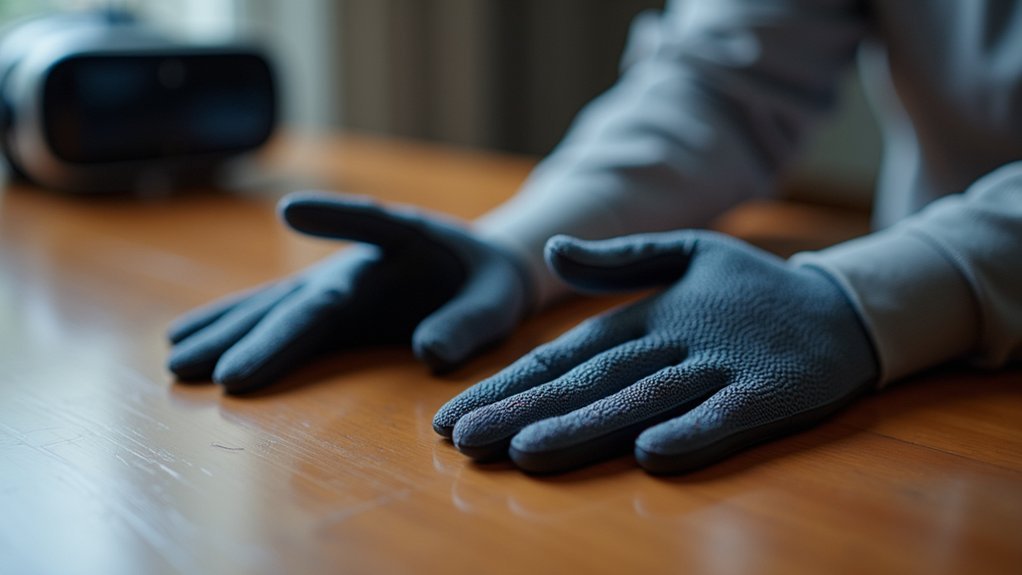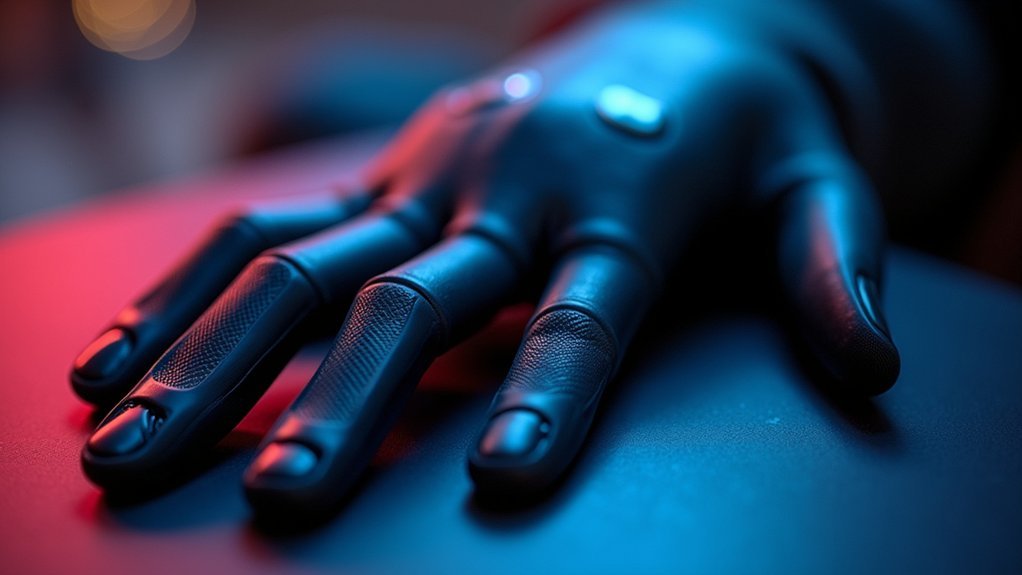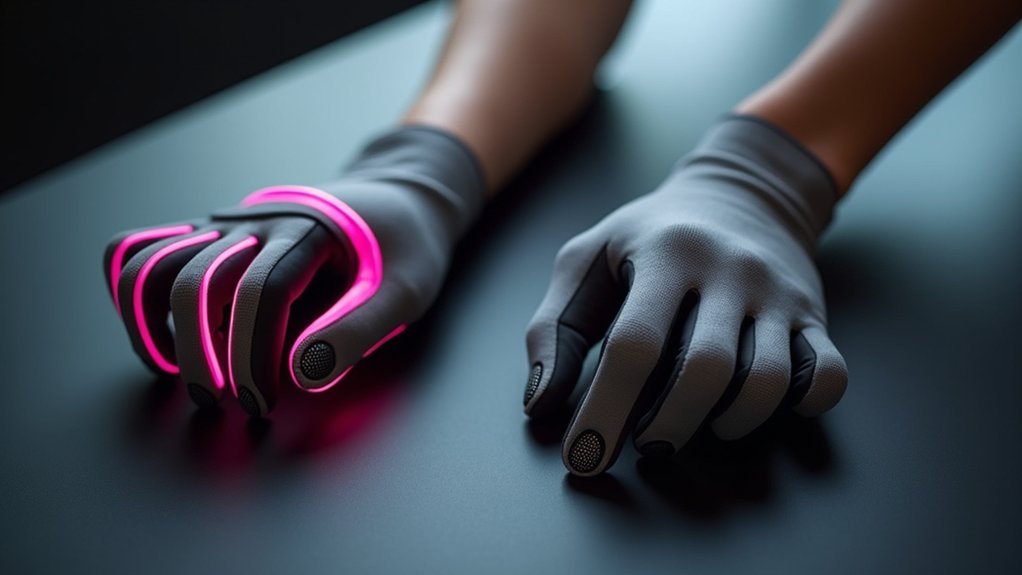When choosing top VR touch gloves, you’ll need to prioritize tracking precision through IMU-based sensors, haptic feedback strength measured in Newtons, and compatibility with your VR headset. Consider whether you need wireless mobility or tethered performance for maximum force feedback. Evaluate comfort features like breathable materials and adjustable fit, plus battery life for extended sessions. Professional-grade options like SenseGlove Nova offer superior capabilities, while budget models provide basic haptic experiences. Understanding these specifications helps you select gloves that match your specific applications and performance requirements.
Understanding VR Haptic Feedback Technology

When you slip on VR touch gloves, you’re experiencing haptic feedback technology that transforms virtual interactions into tangible sensations.
This sophisticated system uses tactile actuators to simulate pressure, texture, and temperature, making virtual objects feel remarkably real.
Force feedback systems employ magnetic friction brakes that let you feel an object’s size and density.
When you grasp a virtual bowling ball versus a feather, you’ll experience authentic resistance differences.
Vibrotactile feedback adds surface texture simulation and button click sensations through specialized actuators.
Advanced sensors track your finger movements with exceptional precision, ensuring accurate gesture recognition.
Emerging technologies like pneumatic actuators and electrical stimulation promise even more nuanced sensations.
Understanding these haptic feedback mechanisms helps you evaluate VR gloves based on the tactile experiences they deliver.
Key Features That Define Quality VR Touch Gloves
When you’re evaluating VR touch gloves, you’ll need to understand the different haptic technology types that create realistic sensations in your hands.
The most advanced systems use force feedback, vibrotactile actuators, and thermal modules to simulate everything from object weight to surface textures.
Your gloves’ tracking precision standards will determine how accurately your real-world hand movements translate into the virtual environment, with IMU sensors and optical tracking being the gold standards for responsiveness.
Haptic Technology Types
Understanding haptic technology types becomes essential as you evaluate VR touch gloves, since these systems determine how realistically you’ll feel virtual objects and environments.
Force feedback represents the most powerful haptic feedback technology, delivering up to 20 Newtons of resistance like the SenseGlove Nova. This technology simulates object weight and density effectively.
Tactile feedback uses multiple actuators to create texture and pressure sensations, as seen in HaptX Gloves G1. This system enhances surface detail perception.
Precision tracking employs numerous sensors for accurate finger movement detection, with devices like Sensoryx VRfree® featuring 11 hand-mounted sensors.
| Technology Type | Key Benefit | Example Device |
|---|---|---|
| Force Feedback | Weight simulation | SenseGlove Nova |
| Tactile Feedback | Texture realism | HaptX Gloves G1 |
| Precision Tracking | Accurate movement | Sensoryx VRfree® |
Tracking Precision Standards
Since tracking precision directly impacts your virtual interactions, quality VR touch gloves must incorporate IMU-based tracking systems with multiple sensors that capture every subtle finger movement.
You’ll want gloves equipped with advanced tracking technologies that detect precise hand and finger positioning for accurate virtual environment interaction.
Superior tracking precision separates professional-grade haptic technologies from basic alternatives. Look for systems utilizing multiple IMU sensors positioned strategically across each glove to monitor complex hand gestures and fine motor movements.
This thorough sensor network guarantees your virtual manipulations translate seamlessly into digital actions.
When evaluating VR accessories, prioritize tracking accuracy specifications and sensor density.
The best gloves maintain consistent tracking performance even during rapid movements, preventing lag or drift that disrupts immersion. Quality tracking systems also integrate smoothly with major VR platforms, ensuring reliable performance across different applications and environments you’ll encounter.
Tracking Accuracy and Motion Capture Capabilities

You’ll find that IMU sensor precision forms the backbone of exceptional VR glove performance, determining how accurately your hand movements translate into virtual environments.
Your glove’s finger movement detection capabilities directly impact whether subtle gestures like pinching or pointing register correctly during interaction.
The quality of gesture recognition technology separates premium gloves from basic models, affecting how naturally you can manipulate virtual objects and navigate digital spaces.
IMU Sensor Precision
When evaluating VR touch gloves, IMU sensor precision stands as the cornerstone of immersive virtual experiences.
You’ll find that IMU sensors directly impact your tracking accuracy by measuring real-time hand orientation and motion through accelerometers, gyroscopes, and magnetometers.
Advanced haptic solutions like Sensoryx VRfree® Gloves combine multiple hand-mounted sensors with IMU technology to deliver exceptional precision in three-dimensional space.
You should prioritize gloves offering individual finger tracking, such as the Manus Prime X, which features dedicated haptic modules for each digit.
This granular approach enables nuanced interactions with digital objects, making your virtual manipulations feel natural and responsive.
The thorough tracking capabilities of quality IMU sensors considerably enhance realism in training simulations and gaming applications, transforming your virtual interactions into believable experiences.
Finger Movement Detection
Advanced finger movement detection systems separate premium VR gloves from basic alternatives through their sophisticated tracking accuracy and motion capture capabilities.
When you’re evaluating haptic gloves, you’ll find that high-quality models employ multiple sensors to deliver precise finger movement detection vital for immersive virtual experiences.
The Sensoryx VRfree® demonstrates this through its 11 hand-mounted IMU sensors, providing accurate tracking without requiring base stations.
Similarly, Manus Prime X Haptic gloves feature individual haptic modules for each finger, enabling granular gesture control.
HaptX Gloves take this further with built-in motion capture systems that mirror real-life hand movements with remarkable precision.
These advanced capabilities become fundamental when you’re using VR for training simulations, where accurate finger tracking directly impacts your ability to manipulate virtual objects effectively.
Gesture Recognition Technology
While finger movement detection forms the foundation, gesture recognition technology elevates VR gloves through sophisticated algorithms that interpret your hand movements into meaningful commands and interactions.
Advanced sensors like IMUs and optical tracking systems deliver the precision you need for real-time motion capture. This haptic VR technology transforms how you interact with virtual environments through accurate gesture interpretation.
Key features that define superior gesture recognition include:
- Multi-sensor integration – IMUs and optical tracking work together for enhanced accuracy
- Real-time processing – Instantaneous gesture interpretation without noticeable lag
- Individual finger tracking – Granular control through dedicated haptic modules per finger
- Force feedback systems – Tactile feedback that responds to your movements and virtual object interactions
- Robust resistance capabilities – Up to 20 Newtons of force for realistic tactile experiences
Force Feedback Systems and Tactile Response

How convincingly can virtual reality gloves trick your hands into believing they’re touching real objects? Force feedback systems create this illusion by applying measured resistance when you interact with virtual objects. You’ll feel weight, texture, and surface properties through pneumatic actuators and vibration motors that deliver tactile response.
| Glove Model | Force Output | Key Technology |
|---|---|---|
| HaptX Gloves G1 | 175 Newtons | 130 tactile actuators |
| SenseGlove Nova | 20 Newtons | Robust force-feedback |
| Meta Haptic Glove | Variable | Pneumatic actuators |
| bHaptics TactGlove | Moderate | Neuromorphic algorithms |
| Standard VR Gloves | Minimal | Basic vibration |
Advanced gloves like HaptX replicate tissue resistance for surgical training, while emerging models use neuromorphic algorithms for realistic haptic feedback. You’ll experience genuine sensations of temperature, texture, and material density, transforming virtual interactions into convincing physical experiences.
Comfort and Ergonomic Design Considerations
Your hands deserve better than cramped, sweaty gloves during marathon VR sessions. Comfort and ergonomic design directly impact your immersive experience, making these factors non-negotiable when selecting VR touch gloves.
Marathon VR sessions demand gloves that prioritize comfort and ergonomic design—these aren’t luxuries, they’re essential for true immersion.
Essential comfort features include:
- Breathable materials with moisture-wicking properties to prevent overheating
- Adjustable fit options accommodating different hand sizes and shapes
- Lightweight design enabling natural hand movements without strain
- Strategic padding around fingers and palms protecting against pressure points
- Snug-but-not-tight fit balancing precise tracking with unrestricted movement
You’ll want gloves that feel like a second skin rather than bulky accessories. Proper ergonomic design guarantees your hands won’t fatigue during extended sessions, while lightweight construction maintains dexterity for complex gestures.
The right balance delivers precise finger tracking and tactile feedback without sacrificing comfort.
Wireless Vs Tethered VR Glove Configurations
You’ll face a fundamental trade-off when selecting VR gloves: wireless models offer unrestricted movement and enhanced mobility, while tethered versions deliver superior haptic feedback and force resistance.
Wireless gloves like the SenseGlove Nova eliminate cable constraints and provide lighter, more comfortable designs that work seamlessly with popular VR headsets.
Tethered options such as the HaptX Gloves G1 leverage direct connections to powerful computing systems, enabling advanced haptic technologies that require substantial power and data bandwidth for enterprise-grade applications.
Wireless Freedom Benefits
When you’re selecting VR touch gloves, the choice between wireless and tethered configurations dramatically impacts your virtual reality experience.
Wireless VR gloves offer unparalleled freedom that transforms how you interact in virtual environments.
Here’s why wireless configurations deliver superior benefits:
- Unrestricted Movement: You’ll enjoy complete freedom without cables constraining your natural hand gestures and body movements.
- Enhanced Portability: Setup becomes effortless across different locations, making them ideal for professional training and design applications.
- Advanced Technologies: IMU-based tracking eliminates base station requirements while maintaining precise hand detection.
- Reduced Fatigue: Extended sessions become more comfortable without cable management distractions.
- Flexible Power: Rechargeable batteries enable use anywhere without tripping hazards.
This wireless freedom creates a more immersive experience, especially during extended professional sessions in healthcare, automotive design, and training simulations.
Tethered Power Advantages
While wireless configurations excel in mobility, tethered VR gloves deliver unmatched power and performance that wireless alternatives can’t replicate.
You’ll experience superior force feedback and tactile sensations through their direct computer connection, enabling high-fidelity simulations that wireless models simply can’t match. This makes tethered VR gloves essential for precision-demanding applications like surgical training, where accuracy matters most.
You’ll also benefit from enhanced durability and reliability since tethered configurations aren’t susceptible to connectivity issues, latency, or unexpected disconnections that plague wireless alternatives.
The consistent power supply allows for complex haptic feedback delivery, including detailed textures and realistic weight perception. When your application requires the highest level of tactile precision and uninterrupted performance, tethered gloves provide the robust foundation you need.
Compatibility With Popular VR Headsets
Before investing in VR touch gloves, you’ll want to verify they’re compatible with your specific headset since not all gloves work seamlessly across different VR systems.
Major VR headsets like Oculus Quest, HTC VIVE Pro 2, and Meta Quest 2 support various glove models, but you’ll need to check specifications carefully.
Here’s what compatibility means for popular VR touch gloves:
- SenseGlove Nova – Works across multiple VR headsets, making it ideal for enterprise training
- HaptX Gloves G1 – Compatible with high-end VR systems for industrial applications
- Manus Prime X Haptic – Integrates with Unreal Engine and Unity development platforms
- bHaptics TactGlove – Designed specifically for consumer systems like Meta Quest 2
- Most gloves – Require proper software integration for full functionality
Always verify compatibility before purchasing to guarantee peak performance with your VR setup.
Price Range Analysis for Different User Categories
Once you’ve confirmed your VR headset compatibility, the next consideration becomes budget allocation, as VR touch gloves span dramatically different price points depending on your intended use case.
Your price range analysis should start with identifying whether you need enterprise applications or consumer-level functionality.
For professional training and simulations, the SenseGlove Nova 2 at $5,999 delivers premium haptic feedback technology.
Mid-range enterprise users can consider the Nova Blue at $4,399, offering advanced features with better affordability.
Consumer-focused options include bHaptics TactGlove for casual gaming experiences.
Budget-conscious professionals might choose StretchSense Studio Gloves at $795 for motion capture work.
Developers and creators can explore emerging products like Gloveone or Manus VR, priced between $230-$250, providing cost-effective entry points into VR development.
Professional Vs Consumer-Grade VR Gloves
Understanding your specific use case determines whether you’ll benefit from professional-grade VR gloves or consumer models, as these categories serve fundamentally different purposes.
Choosing between professional and consumer VR gloves depends entirely on your intended application and performance requirements.
Professional-grade VR gloves like the HaptX Gloves G1 and SenseGlove Nova deliver enterprise-level performance with sophisticated haptic feedback systems featuring multiple actuators and force feedback capabilities. They’re engineered for training simulations and complex interactions requiring high-resolution sensing.
Consumer-grade VR gloves such as the bHaptics TactGlove focus on accessibility and gaming enhancement. While they provide basic haptic feedback and finger tracking, they lack the precision of professional models.
Key differences include:
- Price: Professional models cost around $5,999 vs. consumer options starting at $230
- Feedback quality: Advanced multi-actuator systems vs. simplified feedback
- Applications: Enterprise training vs. casual gaming
- Compatibility: High-end systems vs. broader platform support
- Precision: High-resolution sensing vs. generalized responses
Battery Life and Power Management Features
You’ll want gloves with low-power modes or automatic sleep functions that conserve energy during inactivity.
Consider charging time too—some models require hours for full recharge, while others offer quick charging for rapid session turnaround.
Software Integration and Developer Support
While hardware capabilities matter greatly, the software ecosystem surrounding your VR gloves can make or break your development experience.
The software ecosystem can make or break your VR glove development experience, regardless of hardware quality.
You’ll want gloves that seamlessly integrate with major software platforms like Unreal Engine and Unity to maximize your development potential.
When evaluating options, prioritize these essential features:
- Extensive SDKs and APIs for simplified haptic feedback and motion tracking implementation
- Cross-platform compatibility across multiple VR headsets and operating systems
- Strong developer support through active forums and detailed documentation
- Regular software updates that enhance functionality and maintain compatibility
- Robust community resources for troubleshooting and knowledge sharing
Quality developer support accelerates your projects and reduces implementation headaches.
Choose manufacturers who actively maintain their software ecosystem and provide responsive technical assistance when you encounter challenges.
Durability and Build Quality Assessment
Beyond software compatibility, your VR gloves must withstand the physical demands of regular use across diverse applications.
When evaluating haptic gloves, prioritize enterprise-grade durability like the HaptX Gloves G1, which features robust materials designed for industrial training environments.
Examine build quality through high-quality stitching and materials, as demonstrated by the SenseGlove Nova series that balances comfort with structural integrity.
Weight matters for extended use – lightweight options like the SenseGlove Nova maintain portability without compromising durability.
Check resistance ratings; HaptX Gloves G1’s 175 Newtons pressure capability indicates superior handling without degradation.
Research feedback from industry professionals who’ve tested gloves in demanding real-world applications, as their long-term performance reveals true durability beyond manufacturer specifications.
Real-World Performance in Various Applications
When selecting VR gloves, understanding their real-world performance across different applications reveals how theoretical specifications translate into practical value.
Different VR gloves deliver varying levels of haptic feedback depending on your specific use case.
Enterprise training environments benefit from gloves like the SenseGlove Nova, which provide realistic force-feedback essential for healthcare and automotive design applications.
Here’s how various gloves perform across key applications:
- Medical simulations: HaptX Gloves G1 with 130+ tactile actuators enable precise surgical training through tissue resistance feedback
- Professional training: Wireless options like SenseGlove Nova enhance mobility without tethered constraints
- Gaming applications: bHaptics TactGlove offers affordable entry-level haptic feedback for enhanced entertainment
- Design work: Manus Prime X provides individual finger tracking for detailed virtual reality creative tasks
- Content creation: Advanced gloves improve accuracy and user engagement when you experience virtual reality development
Frequently Asked Questions
What Are the Best VR Haptic Gloves?
You’ll find SenseGlove Nova 2 and HaptX Gloves G1 lead premium haptic experiences with exceptional feedback. For budget-conscious users, bHaptics TactGlove offers solid finger-tracking. Consider your specific needs and budget when choosing.
How Much Do Manus Gloves Cost?
Manus gloves cost around $250 for both the Prime X Haptic and standard VR models. You’ll find this pricing applies whether you’re targeting VR training applications or design work in virtual environments.
How Much Are the Tesla Haptic Gloves?
You can’t purchase Tesla haptic gloves yet because they haven’t announced pricing. Tesla’s still developing these advanced haptic feedback gloves, so you’ll need to wait for official pricing and release information.
How Much Do Haptx Gloves Cost?
You’ll pay around $10,000 for HaptX Gloves G1, making them one of the market’s most expensive options. They’re designed for enterprise use with advanced haptic feedback featuring over 130 tactile actuators.
In Summary
You’ll find the perfect VR touch gloves by balancing your specific needs with available technology. Don’t compromise on tracking accuracy or comfort, as these directly impact your experience. Consider your budget alongside battery life requirements and software compatibility. Test different force feedback systems when possible, and prioritize durability if you’re planning intensive use. Remember that haptic technology’s rapidly evolving, so choose gloves that’ll support future updates and applications.





Leave a Reply